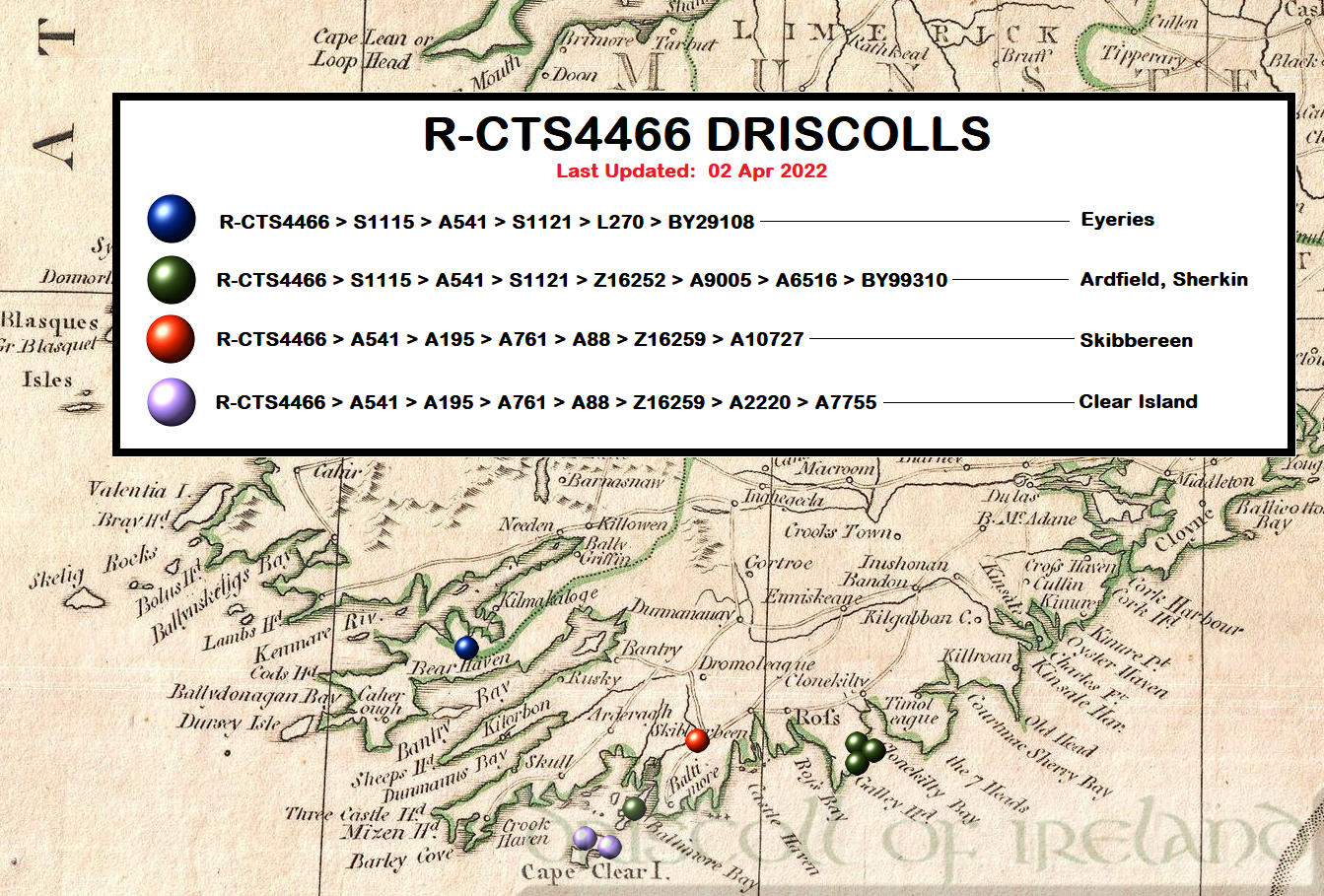Click the image below to start/stop the slideshow.
 Click on image to start/stop slideshow.
Click on image to start/stop slideshow.
R-CTS4466 is a major haplogroup of County Cork and the Province of Munster. It shows considerable variation in its subclade breadth and extent. An informal yDNA survey in a related project, Cork Ireland, shows R-CTS4466 men with Cork paternal line ancestry constituting 38% of the total surveyed in that project the last time the numbers were tallied. No other haplogroup comes close. The Munster Irish yDNA project would probably have better numbers.
The slideshow illustrates the approach of this SNP lineage in the table below toward the British Isles, starting from R-M269.
R1b M415/M343 R1b1 L820 R1b1a L388 R1b1a1 L502 R1b1a1b M269 R1b1a1b1 L23 R1b1a1b1a L51 R1b1a1b1a1 P310 R1b1a1b1a1a L151 R1b1a1b1a1a2 P312 R1b1a1b1a1a2c Z290 R1b1a1b1a1a2c1 L21 R1b1a1b1a1a2c1a DF13 R1b1a1b1a1a2c1a3 FGC11134 R1b1a1b1a1a2c1a3. FGC12055 R1b1a1b1a1a2c1a3. Z3026 R1b1a1b1a1a2c1a3a Z16250/S7942 R1b1a1b1a1a2c1a3a2 CTS4466 |
Our project Driscolls under this haplogroup have a predicted haplogroup of R-M269 when they take a Y STR test. Starting from parent R1b, the mutation progression from there through R-CTS4466 is as shown in the table. Haplogroup R1b, the major parent of R-CTS4466, is by far the most predominant Y haplogroup in Europe and in Ireland today. It has a heavy presence in Eurasia. From R1b subclades came the haplogroups that have a particularly strong presence within Ireland - carving out the O'Neill dynasty in the north as well as Leinster and North Sea groups to the east and the Dal Cais and Eoghanaght groups in the south. The expansion of R1b into Europe occurred largely during the Neolithic. By comparison, I2a had inhabited Europe much earlier. R-L21 is known for its presence along the Atlantic coasts of Europe. It has been correlated with the Western Atlantic haplotype. FGC11134, a well known parent to CTS4466, is currently estimated to have formed about 2100 B.C.E. CTS4466 was formed about 1200 B.C.E. and started an explosive expansion about 200 C.E. |
Driscoll yDNA project members confirmed or thought to be R-CTS4466 constitute about 20% of the project at large.
R-CTS4466 project members are advised to join the R-CTS4466Plus Project and (if of Munster origin) - the Munster Irish yDNA Project. Some of the same team manage both projects. Besides those FTDNA-based projects, another project of interest is Haplogroup R, which takes data from multiple sources. It publishes an experimental R-FGC11134 tree, showing branches of R-CTS4466 that have not shown up in YFull, FTDNA or ISOGG. It shows a sequence of SNPs between FGC11134 and CTS4466. R-CTS4466 Driscolls who have done advanced SNP testing are encouraged to submit their BAM file to Haplogroup R.
Our map of County Cork here pins terminal SNPs to known ancestral locations.
Refer to our analysis page for details of the subclade structure of R-CTS4466 and time estimates.
Not all R-CTS4466 Driscoll branches have been traced to a location in Ireland on the map below, and not all Driscoll project members in known branches are drawn on the map. Many of the earliest Driscoll project members who have since lost interest, gone missing or passed away probably fell into R-CTS4466. They or their beneficiaries have not been engaged with the project for many years.

| Driscoll at FTDNA | DNA Portal | Project Pedigrees |
| See ABOUT for website information. | ||
| Copyright © 2010-2024 driscoll.dnagen.org. All rights reserved. | ||


